Mariamman
Māri (/mɒrı/, /maari/), also known as Mariamman ( /mɒrı əˈmʌn/) and Mariaai, both meaning "Mother Mari", spelt also Maariamma, or simply Amman or Aatha ("mother") is the South Indian Hindu goddess of rain. She is the main South Indian mother goddess, predominant in the rural areas of Tamil Nadu and Karnataka. Māri is closely associated with the Hindu goddesses Parvati[1] and Durga[2] as well as with her North Indian counterpart Shitala Devi.
| Maariamman, Maariaatha | |
|---|---|
Rain | |
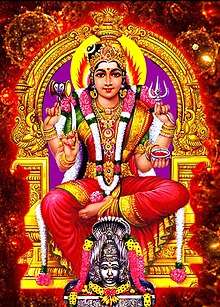 Goddess Mariamman | |
| Abode | [hearts of good peaple]] (as Athiparasakthi) |
| Weapon | Triśūlam |
| Adherents | Hindus |
| Mount | Lion |
Her festivals are held during the late summer/early autumn season of "Aadi" throughout the Tamil Nadu and Deccan region, the largest being Aadi Thiruvizha. Her worship mainly focuses on bringing rains and curing diseases like cholera, smallpox, and chicken pox. Maariamman is worshipped in accordance with the local Agamas as Pidari or the Gramadevata. Mariamman is very popular in South India. She is considered as the protector (kaval deivam) by many people residing in south India.
Origin
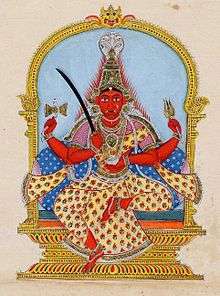
Mariamman is a Hindu goddess, whose worship probably originated in pre-Vedic India. She is the main Tamil mother goddess, predominant in the rural areas of Tamil Nadu. In the post-Vedic period, Māri was associated to Hindu goddesses like Parvati,[3] Kali and Durga[4] as well as with her North Indian counterpart Shitala Devi and Eastern Indian counterpart Manasa.
The word Mari (pronunciation: /maari/) has a Sangam Tamil origin meaning "Rain" and the Tamil word Amman means "Mother". She was worshipped by the ancient Tamils as the bringer of rain and thus also the bringer of prosperity, since the abundance of their crops was dependent largely upon adequate rainfall. The cult of the mother goddess is treated as an indication of a society which venerated femininity. The temples of the Sangam days, mainly of Madurai, seem to have had priestesses to the deity, which also appear predominantly as goddesses.[5] In the Sangam literature, there is an elaborate description of the rites performed by the Kurava priestess in the shrine Palamutircholai.[6]
Worship
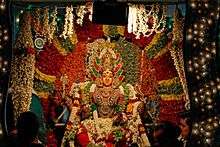
The worshiping methods are often accompanied by various kinds of folk dancing.[7] Offerings such as pongal and koozh that are cooked using earthen pots are also made during the festive season. Rituals such as fire walking and mouth or nose piercing are also practised.
Mulaikottu
Mulaikottu- is one of the famous Village festivals celebrated particularly in Southern parts of Tamil Nadu, India. It is a long belief of the villagers that by celebrating the festival in their village they could make goddess mariamman happy. By doing so they believe that they can get her blessing and sufficient rain for better cultivation. This festival is generally celebrated inbetween the tamil month of panguni-Aavani .Large number of migrated people from the village due to various reason join together and they share their happiness on the auspicious occasion of Mulaikottu. The festival lasts for 11 days . During these period large number of petty shops will be established to make the even more attractive and enjoyable.
Ccelebration of Mulaikottu
On the auspicious beginning of the village festival, a village meeting will be convened to sort out the best suitable date for the celebration of Mulaikottu. Before fixing any date, the pradhan and secretary of the village gather some information from the villagers regarding any marriage or anyone suffering from chicken pox etc. If anyone is affected by chicken pox, occurred any kind of sudden death or fixing anyone's marriage, under these circumstances the date of mulaikottu will be either postponed or cancelled according to the public opinion at the meeting. The celebration begins with collection of nine different types of grain seeds from every house, we call thandal in Tamil. The Thandal will held in sunday of Valarpirai. The following day of tuesday was the second day of thandal called Pari parapputhal in tamil .Next tuesday, The main function will be held on this day called mulaikottu. On the next day of thandal, the temple committee distribute the grains to every house for setting up of pari.
What is pari?(Also known as mulaipari)
It is nothing but an utensil made up of mud in the same way as like a mud pot or any other mud items. This has wide mouth and shrinked base having hole at the bottom. This utensil is specially made for this purpose and sold at the market. The villagers visit the market and purchase number of paries as they wanted to setup in their home.
How to setup pari at home
The first and foremost step is cleaning of paries and their home on the second day of thandal. People used to collect goat dung and some hay. The hay is used to block the hole of the pari. A layer of goat dung is spread over the hay and watered to make the dung wet. This is the procedure of setting up up of pari.
As a next step to this, the received nine type of grains from the temple committee, is smoothly spread over the goat dung on the pari. Following this, a pooja will be arranged for praying the goddess to make the pari a successful one. Every house may have more than two paries. These paries taken into a dark and isolated room in their house. For the next seven days they have to grow the seedlings into a plant. Usage of loudspeaker and crackers are completely banned during this period. During evening, all villagers assemble in front of the mariamman temple start singing folk songs known as mari pattu and folk dance such as mulaikottu ( similar to kummi) , Amman oyil performed by the villagers . It was followed everyday from thandal sunday(First day) to next sunday(eighth day). The ninth day called thangal in tamil means camping. In this day the temple was closed and folk poojas and dances were prohibited. The Amman karagam was made in village water body and the person who get fasting in those 10 days called Ammadi (The person who depicted as Amman). Ammadi took karagam and gave to temple.All paries will be brought into the amman temple from the houses on the Tenth day of thandal. The paries will remain in the amman temple for one night and on the next day(the last day ,eleventh day, Wednesday) with a great pooja celebration the paries will be issued back to their respective member. The ammadi Again took karagam and the mulaiparies also took up by villagers from temple.Finally,the amman karagam and mulaiparies were submerged into the village pond.
Conclusion:
This is a kind of religious belief and practice to make the goddess mariamman happy and to pray for getting more rain in the future for better cultivation. The village gets a face lift during the celebration of this village festival in southern part of Tamil Nadu.
The tamil playback singer Paravai muniyamma sung song about mulaikottu festival for mariamman in manjal alankari album named marimuthe song
This festival is celebrated in villages of Madurai,Sivagangai,Dindugul,Ramanathapuram,Thoothukudi, Thirunelveli districts of tamilnadu.
It is also celebrated in Madurai Meenakshi amman temple on the tamil month of Aadi.
At the Samayapuram Mariamman Temple in Samayapuram, the Hindu system of worship is still seen today for the worship of Mariyamman, which involves a ten-day festival organized by temple authorities during the second week in April. Some continue to use an old village custom of worship by offering chickens and goats to the deity, though the animals are no longer sacrificed but sold after being offered. The main worship of the goddess occurs on the road a mile or two from the temple. A hurried walk and dance carry hundreds of thousands of worshippers along the road to the temple. Many in the crowd have fasted, shaved their heads, and wear bright yellow clothes which are sacred to the goddess. Women and children may carry a pot on their heads decorated with the goddess’s favourite leaves, of the margosa tree. Young men and women, carrying similar pots, are followed by drummers and dance more wildly. Larger men and women carry pots of charcoal fire. Some put themselves through a special tribulation of having one of the sacred weapons, dagger, trident, or spear, inserted through their cheeks or tongues.[8] Through this worship each individual achieves self-realization and awareness of others through samsara and moksha. In this self-realization a bonding with the goddess occurs, which is the underlining reason for the worship.
Legend
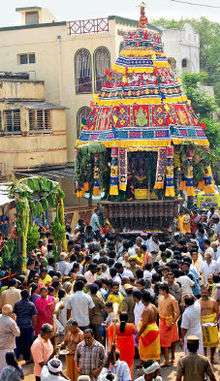
One story about the origin of Maariyamman is found in the Mahabharata, where Draupadi, the wife of Pandavas, is said to be an incarnation of Maha Kali. This was known to no one but Sri Krishna. Draupadi, despite being Maha kali, lived like a normal woman, suppressing her supernatural powers. But during the night, when Pandavas was asleep, she would travel to the Villages of Vanniyar in the form of Maha Kali. Vanniyars would offer her puja and barley, which pleased her. In time Mariyamman become popular in the Vanniyar villages. In Northern India, Sheetla Devi was worshipped in a similar way, predominantly by the Rajput/Kshatriya community. Sheetla Devi has a similar background story and plays a similar role in protecting villages.
The Tamil word 'Muthu' means pearl. In the ancient usage of the language 'Muthu Maari' appears to have been a poetic metaphor for raindrops, which were equated with precious pearls bestowed as the gifts of the Nature goddess. Maariamman was also called Muthu Maariamman, which meant the goddess who gives prosperous rain. From a religious perspective that survived in Mediaeval Europe as the equally poetic doctrine of signatures the pearls of rain may have been thought to heal the pearl-like boils that occur during chickenpox.
A possibly related, and less sympathetic, story involves the beautiful and virtuous Nagavali, wife of Piruhu , one of the nine Rishis. One day, when the Rishi was away, the Trimurti came to test the truth of her famed beauty and virtue. Not knowing them and resenting their intrusion, Nagavali turned them into little children. The gods were offended and cursed her, so her beauty faded and her face became marked as if she had smallpox. The Rishi returned, found her disfigured, and drove her away, declaring she would be born a demon in the next world and cause the spread of a disease which would make people look like her. She was called Mari, meaning 'changed.' then the Rishi consoled her in next generation she will worshipped as a goddess and she repels the diseases from the human beings
Local goddesses such as Mariamman who were believed to protect villages and their lands irrespective of the different castes of their worshippers have always been an important part of the religious landscape of South India. However, we can note periods of special significance. The eclecticism of the Vijayanagar period (1336–1565) encouraged folk religion, which became increasingly important as it influenced the more literate forms of religion. In the last two centuries there has been a rebirth of Tamil self-consciousness (see Devotion to Murukan). In the middle of the 20th century, deities such as Mariamman became linked to the "great tradition" as the strata of society that worshipped the goddess were integrated into the larger social order.
Iconography
Māri is usually pictured as a beautiful young woman with a red-hued face, wearing a red dress. Sometimes she is portrayed with many arms—representing her many powers—but in most representations she has only two or four.
Māri is generally portrayed in the sitting or standing position, often holding a trident (trisula) in one hand and a bowl (kapala) in the other. One of her hands may display a mudra, usually the abhaya mudra, to ward off fear. She may be represented with two demeanours—one displaying her pleasant nature, and the other her terrifying aspect, with fangs and a wild mane of hair.
Goddess of medicine
Mariamman cures all so-called "heat-based" diseases like pox and rashes. During the summer months in South India (March to June), people walk miles carrying pots of water mixed with turmeric and neem leaves to ward off illnesses like the measles and chicken pox. In this way the goddess Māri is very similar to the North Indian goddess Shitaladevi.
Fertility goddess
Devotees also pray to Mariamman for familial welfare such as fertility, healthy progeny or a good spouse. The most favoured offering is "pongal", a mix of rice and green gram, cooked mostly in the temple complex, or shrine itself, in terracotta pots using firewood.
Some festivals in honour of the goddess Māri involve night-time processions of devotees carrying oil lamps. Mariamman is the family deity for many in the Thanjavur district of Tamil Nadu. It is a custom initially to worship the family deity on occasions such as weddings. The worship of a family deity (Kula-theivam), considered most important in any Hindu festival, continues down the generations, providing a clue to the family's origin, since the family deities are usually located within the vicinity of the village to which the family originally belonged.
Temples
Most temples to Mariamman are simple village shrines, where both male and female priests perform sacred rituals. In many rural shrines, the goddess is represented by a granite stone with a sharp tip, like a spear head. This stone is often adorned with garlands made of limes and with red flowers. These shrines often have an anthill that could be the resting place of a cobra. Milk and eggs are offered to propitiate the snake.
Some temples have attained sufficient popularity for Brahmins to officiate at them. For example, the Samayapuram temple near the shore of river Cauvery in the northern outskirts of Trichy, maintains a rich agamic tradition and all rituals are performed by Gurukkals.
Punainallur, near Thanjavur (Tanjore), is the location of another famous Māri temple. Legend says that Mariamman appeared to the King Venkoji Maharaja Chatrapati (1676–1688) of Tanjore in his dreams and told him she was in a forest of Punna trees three miles distant from Tanjore. The King rushed to the spot and recovered an idol from the jungle. On the king's orders a temple was constructed there, the idol installed, and the place was called Punnainallur. Hence the deity of this temple is known as Punnainallur Mariamman. Mud replicas of different parts of the human body are placed in the temple as offerings by devotees pleading for cure. It is said that the daughter of Tulaja Raja (1729–35) of Tanjore, who lost her eyesight due to illness, regained it after worshipping at this temple. Shri Sadasiva Brahmendra is said to have made the Moola Murthy of the Goddess Maariamman from the mud from the ant-hill where snakes had resided.
Salem Kottai Sri Periya Mariamman temple which is located in the heart of the city, the Aadi festival celebrated for 22 days.
The Erode Mariamman temple festival is a grand one in Tamil Nadu. The worship of three Mariamman goddesses named Small, Medium and Large Mariamman (residing at three separate localities within the city) is combined in a festival every April. It features the thiruvilla, along with all the other devotions to God, and ends at the Cauvery river with the purificatory immersion of the kambam (effigy of Mariamman's husband) in the flowing waters of the river.
The Karur Mariamman temple festival, which is celebrated at the end of May each year, is another notable festival held in honour of the goddess in Tamil Nadu.
Other important temples of Mariamman in Tamil Nadu are in the towns of Veerapandi, Theni, Anbil (near Trichy), Narthamalai, Thiruverkadu, Salem, Virudhunagar and Sivakasi, Vellore. In Chennai (Madras), a famous Mariamman temple is the Putthu Mariamman: the eponymous Putthu (ant-hill) being located across the road from the temple on the opposite side of the Velachery Main Road.
In 2012, the singer Harini composed a song about the Samayapuram Mariamman deity which was featured on the album Om Nava Sakthi Jaya Jaya Sakthi. The song narrates the power of Shakti as Samayapuram Amman and equates the Peruvalai River with Punya Theertham, as do the people in that area.[9]
Madurai is home to the Theppakulam sri Mariamman Temple, a noted focus of devotion, primarily to the goddess but also to the Maruthuvachi (= doctor/midwife). Periyachi Amman (or Pechi Amman), who was deified for her skill and heroism. The temple possesses a large theppakulam. Here the Panguni festival is the main event of the religious calendar. The devotees of The goddess Mariamman observe the "poo choridhal" flower festival, and in the month of Aadi many women honour her with fasting and prayer.
Another famous Mariamman temple is situated in the state of Karnataka, in the town of Kaup, seven kilometres from the famous temple town of Udipi.
There is also a famous and highly-regarded Mariamman temple in Urwa, a residential area of the city of Mangalore, where through the power of the goddess many miracles have been reported to occur. The temple is known familiarly as Urwa Marigudi.
Temples Outside India
- Mariamman Temple, Ho Chi Minh City in Vietnam
- Mariamman Temple, Bangkok in Thailand
- Mariamman Temple, Pretoria
- Punnainallur Mariamman
- Samayapuram Mariamman Temple
- Sri Mahamariamman Temple, Kuala Lumpur, Malaysia
- Sri Mariamman Temple, Medan, Indonesia
- Sri Mahamariamman Temple, Penang,Malaysia
- Sri Mariamman Temple, Singapore
- Sri Muthumariamman Temple, Negombo
- Mariamman Temple, Pretoria
- Matale Sri Muthumariyamman Temple, Matale-Sri Lanka
There are many Mariamman temples outside India, in Mauritius, Sri Lanka (Mari Mata Temple Rattan Tallow Akbar Road Saddar Karachi Pakistan, in Karachi 5 Mari Mata Temples, Rattan Tallow Temple Soyam Parghat Temple. In Karachi five temples of Mari Mata). Malaysia, Singapore, Thailand, Fiji, Fiji Maha Shakti Mata Temple Nadi and Suva, Guyana, Vietnam, Trinidad and Tobago, Germany[10] and South Africa, the product of efforts of the Tamil diaspora. Some notable temples include the Sri Mariamman temple in Singapore, Sri Mariamman temple in Bangkok, a Mariamman temple in Pretoria, South Africa, as well as one in Sri Mariamman Temple, Medan, Sri Mariamman Temple Karachi Pakistan, (Marathi Peoples Calling=Mari Aayi)(Shri Mari Mata Temple Rattan Tallow Akbar Road Saddar Karachi Pakistan.) Indonesia.
There are also many Mariamman temple in every state of Malaysia. Some notable temples include the Queen Street Sri Mahamariamman Temple, Penang in George Town, Sri Sithala Maha Mariamman Temple, Pekan Getah Tapah,Lorong Kulit Sri Muthu Mariamman Temple in George Town, Sri Rudra Verra Muthu Mahamariamman Temple in Air Itam, Sri Maha Mariamman Devasthanam in Arau, Sri Maha Mariamman Devasthanam in Alor Setar, Sri Maha Mariamman Temple in Sungai Petani, Sri Maha Mariamman Temple in Ipoh, Sri Nagamuthu Mariamman Temple in Taiping, Sri Maha Mariamman Temple in Gopeng, Sri Mahamariamman Temple, Kuala Lumpur, Sri Maha Mariamman Temple in Klang, Sri Maha Mariamman Temple in Chukai, Sri Maha Mariamman Temple in Port Dickson, Sri Maha Mariamman Temple in Kuantan, Sri Veera Sundara Muthu Mariamman in Kulim, Raja Mariamman Temple in Johor Bahru, Sri Maha Muthu Mariamman Temple in Tumpat, Sri Maha Mariamman Temple in Kuching and Sri Maha Mariamman Temple in Sibu.
Hindu tradition
In Hindu tradition, Mariamman is the sister of Lord Vishnu (Sriranganathar) and called Mahamaya.
The Samayapuram Mariamman is worshipped on the first day of the Tamil month of Vaikasi by the Iyengar/Srivaishnava Brahmins of Srirangam. They claim that she is the sister of Lord Renganath (a form of Vishnu) of Srirangam. This is the second most prominent temple in Tamil Nadu, following Palani, on the basis of income.
Another version of the traditions suggests she is the mother of Parasurama, Renukadevi who is appeased for rains. She is also known as Sri Chowdeshwari Devi in most of the parts of Karnataka and Andhra Pradesh. In Mysore region she is worshipped as both Chowdeshwari Devi and as well as Mariamman. There are many instances where Mariamman has appeared to people in form an old woman wearing red sari with green bangles and three mangalsutras. She is also regarded as the Gramdevata of certain villages, thus reducing the incidence of contagious disease in these villages. Another version depicts her as Pattalamma, goddesses of truthfulness and punctuality. She is said to punish any villager failing to practice these virtues.
In reference to Sanskrit stotras, it is suggested Mariamman is not sister of Lord Visnu rather feminine aspect of Lord. The Lord incarnates in this form during Kali yuga, when knowledge is almost void or ignorance at peak. Even few refer or map to other female goddess like Renuka devi, none of them have been proved or validated. The Mariamman represents core aspects of Lord in form of curative aspect to signify direction and awakening of knowledge. She is referred as MahaLakshmi, Mahasaraswati and MahaKali. Varamahalakshi is dedicated to Mariamman. It also represents finite aspect of infinite qualities.
- The Nanalthidal Mariamman, Kattucherry near Porayar, Tamil Nadu
 Mariamman temple in a village in Tamil Nadu
Mariamman temple in a village in Tamil Nadu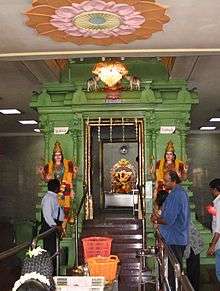
See also
- Draupadi Amman
- Isakki
- Madurai Veeran
- Pidari
- Maisamma
- Kateri Amman
Notes
- "ஆயி உமையானவளே ஆதிசிவன் தேவியரே" (Oh Mother Uma, Consort of Siva!) - Mariamman Thalattu, Goddess Mari Prayer.
- "The truthful Kali who guarded the homesteads sat with her, The Kali sat together with Durga continuously with her" _Mariamman Lullaby
- "ஆயி உமையானவளே ஆதிசிவன் தேவியரே" (Oh Mother Uma, Consort of Siva!) - Mariamman Thalattu, Goddess Mari Prayer.
- "The truthful Kali who guarded the homesteads sat with her, The Kali sat together with Durga continuously with her" _Mariamman Lullaby
- Manickam, Valliappa Subramaniam (1968). A glimpse of Tamilology. Academy of Tamil Scholars of Tamil Nadu. p. 75.
- Lal, Mohan (2006). The Encyclopaedia Of Indian Literature (Volume Five (Sasay To Zorgot), Volume 5. Sahitya Akademi. p. 4396. ISBN 8126012218.
- M.K.V.Narayan, Exploring the Hindu Mind: Cultural Reflection and Symbolism, Readworthy, 2009, pp 93
- Younger, Paul. "Journal of the American Academy of Religion." A Temple Festival of Māriyamman (1980): 493-513. ATLA Religion Database. Web. 28 Sept. 2014.
- Samayapuram Mariamman Song by Harini
- "Temples : Sri Maha Mari Amman Temple, Germany". Dinamalar. 2007-12-28. Retrieved 2011-10-29.
References
- ^ Kolenda, Pauline Pox and the terror of Childlessness: Images and Ideas of the Smallpox Goddess in a North Indian Village in P. Kolenda Caste, Cult and Hierarchy: Essays on the Culture of India (New Delhi: Folklore Institute, 1983) 198–221
- ^ Rigopoulos, Antonio The life and teachings of Sai Baba of Shirdi State University of New York press, Albany, (1993) ISBN 0-7914-1268-7 pages 78, 80, 160, 224, 226, 250
External links
| Wikimedia Commons has media related to Mariamman. |

